
The company — which hard drive specialist Western Digital purchased from Hitachi back in 2012 — has been working on utilizing helium in its designs for some years, supplying devices to companies like Netflix that are in need of cutting-edge storage solutions.
Replacing the air in a hard drive with helium offers a host of advantages. Moving parts have less turbulence to work against, so it can drastically reduce power consumption. There are also benefits with regards to storage size, especially given the Shingled Magnetic Recording (SMR) technique that’s being used in the Ultrastar Archive Ha10.
SMR is the advance that has allowed HGST to begin producing 10TB drives, according to a report from Extreme Tech. Rather than laying tracks side by side, they’re allowed to overlap slightly like the shingles on a roof. The downside to this technique is that it’s not as conducive to accessing data regularly as a typical hard drive would allow for. HGST is not the only company using this technology, as Seagate used it to create an 8TB hard drive late last year.
It’s not likely that SMR will be implemented beyond its current usage in enterprise settings any time soon. However, while it’s not well suited to normal consumer use, it’s still a potent solution for businesses. As the technology continues to be refined, it may turn out that HGST can repurpose it for more widespread use — but there are also plenty of other companies looking for their own breakthrough to jump-start the next generation of storage.


